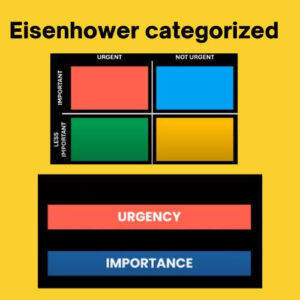The Eisenhower Matrix is a great tool for increasing productivity and streamlining time management.
Its beginnings are strongly related to Eisenhower’s overarching theory of leadership and decision-making. While Dwight D. Eisenhower, the 34th President of the United States, popularized this priority notion, it was founded on his military experience and strategic approach.
One lesser-known truth is that Eisenhower’s decision-making strategy went beyond the urgency-importance matrix. He believed in the idea of “delegated responsibility.” This concept included not just prioritizing work based on urgency and relevance but also delegating properly to maintain smooth operations. It relates to the notion of “mission command,” a military philosophy that emphasizes decentralized decision-making. This larger context helps to understand why the Eisenhower matrix became such a powerful tool for personal and corporate effectiveness.
Let’s take a deep dive into how the Eisenhower Matrix for Productivity works and how it may boost your work efficiency.
What is the Eisenhower Matrix?
The matrix classifies activities according to two essential criteria: urgency and significance.
If we take a minute to analyze everything we do daily against these two characteristics, we’ll be amazed at where all of our time goes.

The Eisenhower Matrix is a four-quadrant framework that allows you to categorize tasks by urgency and importance. It’s a simple but effective way to prioritize your workload and manage your time more efficiently. The matrix is divided into four quadrants:
- Quadrant 1: Urgent and Important
- Quadrant 2: Not Urgent but Important
- Quadrant 3: Urgent but Not Important
- Quadrant 4: Not Urgent and Not Important

Quadrant 1: Urgent and Important
Quadrant 1 contains tasks that are both urgent and important. These are critical issues that need immediate attention. This quadrant often includes crises, tight deadlines, and essential meetings. To stay on top of your responsibilities, it’s crucial to focus on these tasks first. If ignored, they can escalate quickly, leading to significant problems.
Examples of Quadrant 1 Tasks
- Project deadlines
- Crisis management
- Emergency meetings
- Critical client issues
Quadrant 2: Not Urgent but Important
Quadrant 2 encompasses tasks that are important but not urgent. This quadrant represents long-term goals, personal development, and relationship building. Although these tasks don’t have pressing deadlines, they are vital for your future success. Investing time in Quadrant 2 can prevent Quadrant 1 crises from arising in the first place.
Check out this post: Posting Multiple Pictures on LinkedIn for job seekers
Examples of Quadrant 2 Tasks
- Strategic planning
- Skill development
- Exercise and health routines
- Building relationships
Quadrant 3: Urgent but Not Important
Quadrant 3 includes tasks that are urgent but not particularly important. These are distractions that demand your attention but add little value to your long-term objectives. This category often comprises unscheduled meetings, random emails, and unnecessary phone calls. The key is to minimize these distractions and keep them from consuming your time.
Examples of Quadrant 3 Tasks
- Unplanned meetings
- Non-critical emails
- Social media notifications
- Interruptions from colleagues
Quadrant 4: Not Urgent and Not Important
Quadrant 4 contains tasks that are neither urgent nor important. This quadrant represents activities that are often time-wasting and offer little to no value in terms of productivity or personal growth. To boost your efficiency, aim to minimize time spent in this quadrant.
Examples of Quadrant 4 Tasks
- Binge-watching TV shows
- Mindless social media scrolling
- Excessive gaming
- Unproductive hobbies
How to Use the Eisenhower Matrix to Improve Productivity
Now that you understand the four quadrants, here’s how to use the Eisenhower Matrix to enhance your productivity:
- Prioritize Quadrant 1 Tasks: Focus on addressing urgent and important tasks first to prevent crises from worsening.
- Invest Time in Quadrant 2: Devote time to important but not urgent tasks to build a strong foundation for the future. This can reduce the frequency of crises in Quadrant 1.
- Minimize Quadrant 3 Distractions: Reduce interruptions by setting boundaries, delegating when possible, and using time-blocking techniques.
- Avoid Quadrant 4 Activities: Limit time spent on non-urgent, non-important activities to stay focused on your goals.
Conclusion
The Eisenhower Matrix is a useful tool for managing your time and increasing productivity. Using this framework, you may shift from a reactive to a proactive attitude, helping you to achieve your goals with more clarity and concentration. Try it and observe how it changes your approach to everyday chores and long-term goals.
Check out Also Reviews of Top Rated CCTV Camera Products

